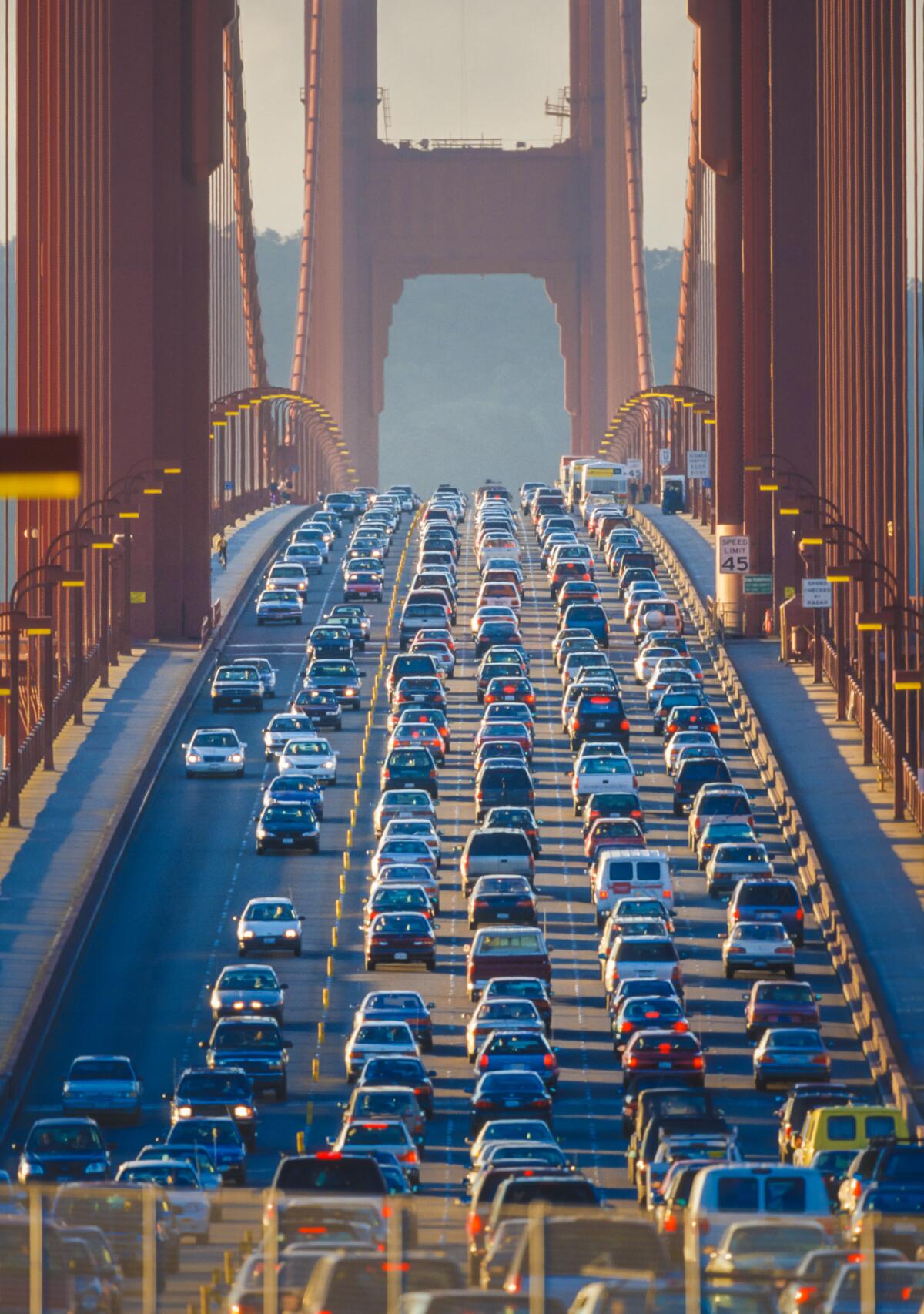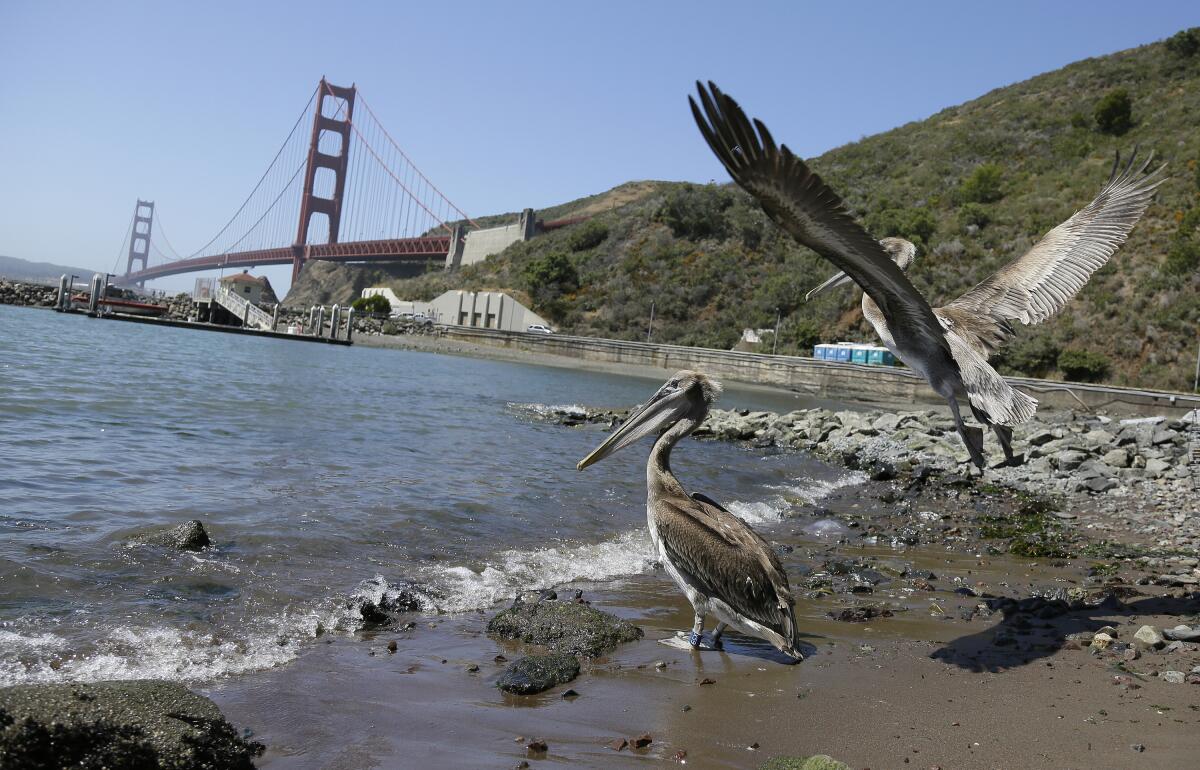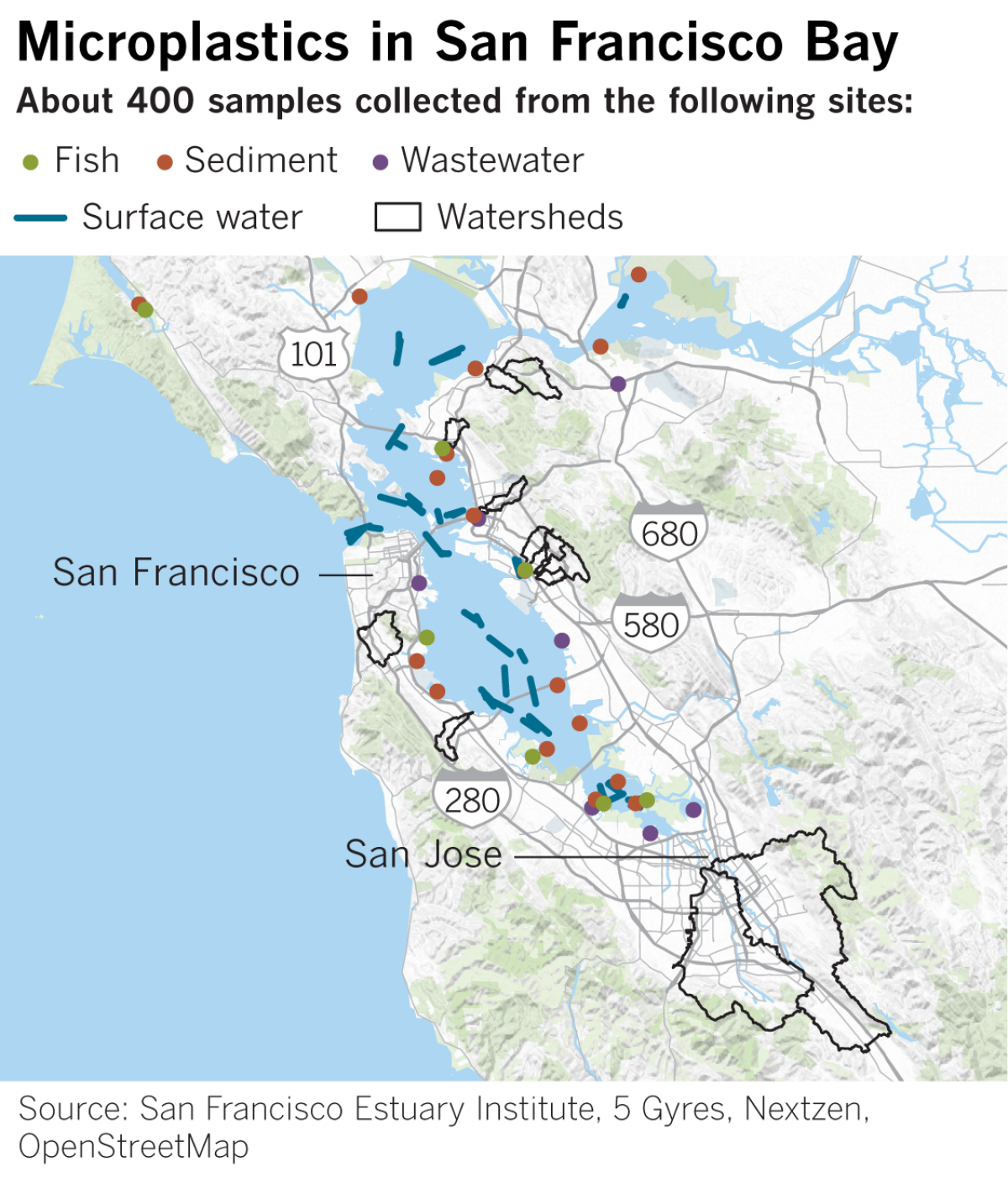The biggest likely source of microplastics in California coastal waters? Our car tires

BERKELEY — Driving is not just an air pollution and climate change problem — turns out, it just might be the largest contributor of microplastics in California coastal waters.
That is one of many new findings, released Wednesday, from the most comprehensive study to date on microplastics in California. Rainfall washes more than 7 trillion pieces of microplastics, much of it tire particles left behind on streets, into San Francisco Bay each year — an amount 300 times greater than what comes from microfibers washing off polyester clothes, microbeads from beauty products and the many other plastics washing down our sinks and sewers.
These tiny plastics, invisible to the naked eye, have been vilified for tainting water and wildlife but are notoriously difficult to study. They’re everywhere and seemingly come from everywhere. They wash into the ocean in all different shapes and sizes, many covered with dyes and chemicals. Scientists and labs across the state, the nation and the world haven’t even agreed on how exactly to measure or sample or study them.
So a team of researchers, led by the San Francisco Estuary Institute and the 5 Gyres Institute, a nonprofit research group focused on reducing plastic pollution, set off to create an inventory of sorts to identify all the ways these different microplastics were getting into San Francisco Bay. They analyzed hundreds of samples from fish, sediment, surface water, wastewater and stormwater runoff and tried to trace the origins of all these particles.
Mark Gold, who heads the state’s Ocean Protection Council and was recently appointed the state’s deputy secretary for ocean and coastal policy, said he was surprised that car tire particles were such a large source.
“I’m so used to thinking of the toxics that come from urban runoff and not the actual physical particles from something like tire dust,” said Gold, who has worked for 30 years on cleaning up California’s beaches and oceans from toxic chemicals. “But the sheer number of particles … the scope and scale of this problem makes you realize that this is something that’s definitely worth looking at a great deal more seriously.”
Once plastic enters the environment, it breaks down into smaller and smaller pieces but never goes away. The tiny particles make their way into the ocean, into the stomachs of marine animals, and ultimately become part of the food and water people consume.
A recent UC Davis study sampled seafood sold at local markets in Half Moon Bay, Calif., and found that one-quarter of the fish and one-third of the shellfish contained plastic debris. A survey comparing 150 tap-water samples from five continents found synthetic microfibers in almost every sample — 94% in the United States.
Microplastics have been found in Lake Tahoe, in the deep, deep ocean — even in the Arctic, one of the most remote regions in the world. A scientific review of 52 studies recently concluded that humans on average consume a credit card’s worth of microplastic each week. The European Union is trying to classify microplastics as a contaminant that is unsafe at any level of discharge.
“We’re using more and more plastic and it’s showing up as a footprint on the seafloor,” said Jennifer Brandon, a microplastics biologist at UC San Diego’s Scripps Institution of Oceanography whose research found that since the 1940s, the amount of microscopic plastics has doubled about every 15 years. “It begs the question: Is this what our civilization is going to be remembered for?”

Microplastics are commonly defined as plastic particles smaller than 5 millimeters and classified into five general shape categories: foam, “sphere or pellets,” such as microbeads; jagged “fragments” from larger plastic debris; “film,” such as breakdowns from plastic bags and wraps; and “fibers,” from the likes of textiles, fishing gear and even cigarette filters. Rubber is also considered plastic, both natural (isoprene) and synthetic (styrene butadiene).
These particles often contain harmful chemical additives such as flame retardants or plasticizers, but the overwhelming diversity in size and chemical composition also makes toxicity difficult to predict, let alone study.
What’s missing right now is a systematic approach to evaluating all these different microplastics. When every study does it differently, it’s hard to compare results, said Susanne Brander, an environmental toxicologist at Oregon State University.
As for rubber fragments, they can be toxic because of the fossil-fuel-associated compounds that they’re likely picking up. The San Francisco findings, Brander added, are a window into other populated coastal areas with so many bridges and roads crisscrossing the watershed.
San Francisco Bay is a good laboratory for investigating this emerging contaminant in an urban environment. Essentially a bathtub surrounded by more than 7 million people, it ends up trapping many of the contaminants before they disperse into the greater ocean.

In the latest study, a three-year, $1.1-million effort by a large team of researchers, microplastics from almost 400 samples were identified and analyzed with microscopes, tweezers and lasers in an ecotoxicology lab at the University of Toronto. By establishing new standards for doing a large-scale study of a major estuary and creating a baseline for all these diverse plastics, scientists found clues to where all the particles were coming from.
“We wanted to come up with methods that could be duplicated anywhere in North America — to measure the sources, pathways and fates of those various particles … so that we could standardize a definition of the problem,” said Warner Chabot, executive director of the San Francisco Estuary Institute, an independent science think tank whose board draws both from regulating agencies and those being regulated for water quality, as well as public interest groups.
“The goal was to provide the data and the science to define and quantify the microplastic problem and inform policy solutions.”
Researchers collected anchovies and smelt from six sites in the bay and found they had higher particle counts — particularly of man-made microfibers — than those tested in more undeveloped areas. These prey fish are a critical link between contamination in sediment and seawater and the rest of the food web — an indicator of exposure to larger predators and ultimately humans.
Eight wastewater treatment plants in the Bay Area were also examined. More than 90 million microparticles are discharged into the ocean every day through the facilities, the report said.
Sediment samples were also collected from 20 sites. Scientists found that many microplastics do indeed sink and accumulate on the seafloor, and that the highest concentrations of microparticles were in areas that received large volumes of wastewater and stormwater discharges. Public attention and scientific study, they said, need to focus beyond just the plastic floating on the surface.
Scientists were also taken aback by the sheer amount of particles coming from stormwater runoff, as well as the “black rubbery fragments” that made up almost half of all the particles collected from these samples.
“No one had looked at all the water rushing off the streets during rainfall events to see whether that had plastics in it,” said estuary institute scientist Rebecca Sutton, the study’s lead author. “That makes all that driving we do something to think about, not just in the Bay Area, but any setting where there are cars.”
Researchers in California have been working on documenting the presence of microplastics since as early as the 1990s. Studies by the Southern California Coastal Water Research Project found that tiny pre-production plastic pellets, or “nurdles,” have become a ubiquitous presence in Southern California beach sand.
The SCCWRP is now working with officials across the state to standardize the way microplastics are measured and studied. There’s been growing movement on the issue since two state Senate bills, signed into law in September 2018, called for the State Water Quality Control Board to develop plans for quantifying microplastic particles in drinking water by 2021, and for the Ocean Protection Council to come up with a statewide strategy on the problem.
At a gathering Wednesday in Berkeley, top state environmental regulators, policymakers and scientists examined the latest findings. They talked about the need for better filters in washing machines that could trap microfibers, and the benefits of more advanced filtration at wastewater treatment plants
Eliminating plastic at its source will always be the ultimate, though somewhat unrealistic, solution. While people can stop using plastic straws, states can ban microbeads and companies can redesign their shrink wrap, reducing the world’s dependence on automobiles is a tougher nut to crack.
“The answer to many of these stormwater deposits is ... thinking about public transit, getting people out of their cars — all the things that we need to do anyway are just exacerbated by this issue,” said Jared Blumenfeld, who heads the California Environmental Protection Agency.
“Making this report actionable is about legislation, it’s about individual behavior change, it’s about more corporate responsibility. Together, we can make a big change.”
Another idea discussed Wednesday was the use of so-called rain gardens and other nature-based infrastructure that can trap polluted runoff before it reaches the ocean. Designed to remove well-known toxics and metals — while bringing more nature back into the city — a local rain garden was found to capture more than 90% of the microplastics.
“The role of greening cities becomes part of the overall solution.… It’s all part of a complex dance,” Chabot said. “Plastic pollutes the air we breathe, the water we drink, the food we eat. Plastics are a big part of the climate change problem…. Since California is the fifth-biggest economy on Earth, we have the potential to lead the planet with solutions.”







